Here is a distinct view of that which may be found to take place in all consolidated strata, whatever be the composition of the stratum; and it is this appearance which is here maintained to be a physical demonstration, that those strata had been consolidated by means of heat softening their materials. In that case, those stratified bodies, contracting in cooling, form veins and fissures traversing perpendicularly their planes; and these veins are afterwards filled with mineral substances. These are what I have here distinguished as the particular veins of mineral masses; things perfectly different from proper mineral or metallic veins, which are more general, as belonging to immense masses of those strata; and which had been formed, not from the contraction, but from the disrupture of those masses, and by the forcible injection of fluid mineral substances from below. Now these two species of veins, the particular and the general, although occasionally connected, must be in science carefully distinguished; in the one, we see the means which had been employed for the consolidation of the strata; in the other, we see that power by which the strata have been raised from the bottom of the sea and placed in the atmosphere.]
Error never can be consistent, nor can truth fail of having support from the accurate examination of every circumstance. It is not enough to have found appearances decisive of the question, with regard to the two suppositions which have been now considered, we may farther seek confirmation of that supposition which has been found alone consistent with appearances.
If it be by means of heat and fusion that strata have been consolidated, then, in proportion to the degree of consolidation they have undergone from their original state, they should, caeteris paribus, abound more with separations in their mass. But this conclusion is found consistent with appearances. A stratum of porous sand-stone does not abound so much with veins and cutters as a similar stratum of marble, or even a similar stratum of sand-stone that is more consolidated. In proportion, therefore, as strata have been consolidated, they are in general intersected with veins and cutters; and in proportion as strata are deep in their perpendicular section, the veins are wide, and placed at greater distances. In like manner, when strata are thin, the veins are many, but proportionally narrow.
It is thus, upon chemical principles, to be demonstrated, That all the solid strata of the globe have been condensed by means of heat, and hardened from a state of fusion. But this proposition is equally to be maintained from principles which are mechanical. The strata of the globe, besides being formed of earths, are composed of sand, of gravel, and fragments of hard bodies, all which may be considered as, in their nature, simple; but these strata are also found composed of bodies which are not simple, but are fragments of former strata, which had been consolidated, and afterwards were broken and worn by attrition, so as to be made gravel. Strata composed in this manner have been again consolidated; and now the question is, By what means?




